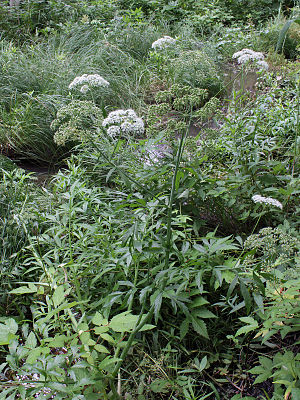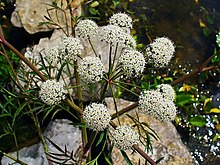Water hemlock
| Water hemlock | ||||||||||||
|---|---|---|---|---|---|---|---|---|---|---|---|---|

Water hemlock ( Cicuta virosa ) |
||||||||||||
| Systematics | ||||||||||||
|
||||||||||||
| Scientific name | ||||||||||||
| Cicuta virosa | ||||||||||||
| L. |
The water hemlock ( Cicuta virosa ), also more precisely poisonous water hemlock or seldom called anger , is a species of the genus water hemlock ( Cicuta ) within the umbelliferae family (Apiaceae). Together with the spotted hemlock , it belongs to the subfamily of the Apioideae .
Along with the spotted hemlock ( Conium maculatum) and the dog parsley ( Aethusa cynapium ), it is one of the most poisonous umbelliferous plants and is said to be perceived by some people as having a bad smell.
description
Vegetative characteristics
The water hemlock grows as a perennial herbaceous plant and reaches heights of 0.5 to 1.5 meters. A bulb-like, thickened stem base is formed as a permanent organ, which is hollow and appears to be chambered by transverse walls.
The two- and three-pinnate leaves have pinnate sections that are linear-lanceolate and sharply serrated.
Generative characteristics
A 10 to 20-rayed double-lobed inflorescence is formed. Bracts of the umbel are missing. The döldchen are profuse and have numerous husk leaves.
The double achenae are only about 2 millimeters wide, almost spherical in shape and characteristically ribbed.
The number of chromosomes is 2n = 22, less often 44.
Ecology and phenology
The water hemlock is a deciduous, helomorphic hemicryptophyte , perennial stem plant or a swamp or rooting water plant . The tubular stem and the bulbous, thickened, compressed base of the shoot have air chambers in the area of the internodes ; this is an adaptation to the oxygen-poor underground. The tubers are also buoyant thanks to the air chambers . Vegetative reproduction takes place through uprooted and floating tubers. The water hemlock survives the winter in the protective leafy layer of the ground.
From an ecological point of view, the pre-male flowers are "nectar-bearing disc flowers". Pollinators are mainly two-winged , particularly hoverflies . The flowering period extends from July to September.
The fruits are covered with floating tissue for swimming spread. The fruits are light and cold germs .
Occurrence
The water hemlock is originally widespread in Eurasia . It thrives in submeridional to boreal climates from flat to hill country . Its distribution area includes Europe, Central Asia, Georgia, Siberia, India, China, Japan, Mongolia and the Far East, plus Alaska and Canada. The water hemlock can be found in wet silting areas of mesotrophic (medium nutrient content) to eutrophic (high nutrient content) stagnant bodies of water such as lakes, ponds or ditches. Further stocks can occur in moist alder forests. Currently, however, its stocks are falling sharply, which is mainly due to the preventive disposal due to the dangerous toxicity and the increasingly intensive use of silting areas. In most of the German federal states, the water hemlock is classified on the red list of vascular plants as endangered or endangered. Also in the rest of Europe he is z. Some of its stocks are severely threatened. He is the Kennart the plant association Cicuto- Caricetum pseudocyperi and has its main deposits in association Alnion glutinosae ( alder ).
Toxicity and Medicine and Botanical History
All plant components of the water hemlock are very poisonous, especially the tubers, which contain about 0.2% cicutoxin . The toxicity is caused by polyines , especially cicutoxin. Ingestion of even small amounts can result in death as a result of respiratory paralysis . According to an old Prussian law, this plant species should be exterminated because of its toxicity .
Even older literature describes poisoning, often after confusing it with edible parsnip roots . A rhizome kills an adult. In Kamchatka , Cicuta is a poison arrow. According to Madaus , ancient authors probably meant the spotted hemlock by Cicuta , which medieval sources usually equate with the water hemlock. Gessner called it Cicuta aquatica , Linné then Cicuta virosa . The herb and the root were used - humoral pathologically considered to be warm and dry - in the past often as an ointment or wrap for relieving pain in gout , rheumatism , hardening of the glands, cramps and convulsive coughs, which was proven in ancient times , and in Russian folk medicine also for sciatica, ulcers and Panaritia . An effect on chorea was also observed.
Common names
The other German-language trivial names exist or existed for the water hemlock : Bärstkraut ( East Prussia ), Bartzenkraut ( Alsace ), Berstekraut, Berzenkraut, Blood hemlock ( Silesia ), Buochalter, Butschürling ( Middle High German ), Dullkraut ( Altmark , Göttingen ), Hunteschervela ( Old High German ) , Pfiffen (Middle Low German ), Piifcruyt (Middle Low German), Pypkrut (Middle Low German), Sackpipes (Middle High German), Sachpfiff (Middle High German), Scaerline (Middle Low German, Dutch), Scarna (Old High German), Scerling (Old High German), Scerling (Old High German), Scereling (Old High German), Old High German), Scerlink, Scering (Old High German), Scerning (Old High German), Scherlinc (Middle High German), Scherlig (Old High German), Schernig (Old High German), Scherring (Old High German), Scherlynck, Schierlenk ( Siebenbürgen Wisshochdeutsch), Schingirling, (Middle High German), Schingirling , Rasende Schirlynk (Middle High German), Serlich (Old High German), Serlink, Sigue (Middle High German) sch), Wätscherling, Wedendunk ( Mecklenburg , East Prussia, Pomerania ), Wedewesle, Wedewessele, Wedescherlingk (Middle High German), Wedeschern (Middle High German), Wedewenn (Middle High German), Wedewindel (Middle High German), Wedewsle (Middle Low German), Weidendung (Pomeranian), Middle High German), Werczling (Old High German) Weydenwispel (Middle Low German), Widerewispeln (Old High German), Winterich (Middle High German), Wintrich (Middle High German), Wintterich (Middle High German), Wintscherling (Middle High German), Wischerlinc (Old High German), Witsching (Middle High German), Witschrecht (Middle High German), Witschrecht ), Witzerling, Wödendunck (Mecklenburg), Wodendunck (Mecklenburg), Wodescern (Old High German), Wodeskerne (Old High German), Wodescerve, Wodescherve, Wodenspele, Wodesterne, Wögendunck, Wordeling (Old High German), Wotich (Old High German), Wotich (Old High German), Wotich (Old High German) Middle High German), Wotscherling (Middle High German), Wotscerlink (Middle Low German), Wotscherlinc (mi ttelniederdeutsch), Woutzerling (Middle High German), Wrugerling, Wüterich, Wuetscherling (Middle High German), Wuntscherlinc (Middle High German), Wuntzerlinc (Middle High German), Wuotrich (Old High German), Wutscherletz (Old High German), Wutscherletz (Old High German), Wutscherdeutschng (Old High German), Wutscherdeutschng (Old High German), Wutscherdeutschng (Old High German), Wutscherdeutschng (Old High German), Wutscherdeutschng (old High German), Wutscherdeutschng (old High German), Wutscherdeutschng (Middle High German) and horny goat.
history
See under Conium maculatum .
literature
- Albert Regel : Contribution to the history of hemlock and water hemlock. - Moscow, 1877. Digitized edition of the University and State Library Düsseldorf
- Ruprecht Düll , Herfried Kutzelnigg : Pocket dictionary of plants in Germany and neighboring countries. The most common Central European species in portrait. 7th, corrected and enlarged edition. Quelle & Meyer, Wiebelsheim 2011, ISBN 978-3-494-01424-1 .
Individual evidence
- ↑ a b c d e f g h Cicuta virosa L., poison water hemlock. In: FloraWeb.de.
- ^ Erich Oberdorfer : Plant-sociological excursion flora for Germany and neighboring areas . With the collaboration of Angelika Schwabe and Theo Müller. 8th, heavily revised and expanded edition. Eugen Ulmer, Stuttgart (Hohenheim) 2001, ISBN 3-8001-3131-5 , pp. 709 .
- ^ Cicuta in the Germplasm Resources Information Network (GRIN), USDA , ARS , National Genetic Resources Program. National Germplasm Resources Laboratory, Beltsville, Maryland. Retrieved May 9, 2018.
- ↑ http://www.giftfotos.com/cicuta_virosa.html , accessed on May 21, 2018.
- ↑ Ruprecht Düll , Herfried Kutzelnigg : Pocket dictionary of plants in Germany. A botanical-ecological excursion companion to the most important species . 6th, completely revised edition. Quelle & Meyer, Wiebelsheim 2005, ISBN 3-494-01397-7 .
- ^ Constantinus Africanus : De gradibus quos vocant simplicium liber. In: Constantini Africani post Hippocratem et Galenum ... Henricus Petrus, Basel 1536, pp. 342–387; here: p. 376 ("Cicuta calida et sicca in tertio gradu ...").
- ↑ JH Dierbach : The Medicines of Hippocrates or attempt to systematically enumerate the medicines that occur in all Hippocratic writings. Heidelberg 1824, p. 232 f.
- ^ Marguerite Louise Baur: Recherches sur l'histoire de l'anesthésie avant 1846. Leiden 1927, pp. 214-218.
- ^ Gerhard Madaus: Textbook of biological remedies. Volume II. Olms, Hildesheim / New York 1979, ISBN 3-487-05891-X , pp. 976-982 (reprint of the Leipzig 1938 edition).
- ^ Georg August Pritzel , Carl Jessen : The German folk names of plants. New contribution to the German linguistic treasure. Philipp Cohen, Hanover 1882, page 99 f. ( online ).
Web links
- Profile and distribution map for Bavaria . In: Botanical Information Hub of Bavaria .
- Water hemlock . In: BiolFlor, the database of biological-ecological characteristics of the flora of Germany.
- Cicuta virosa L. In: Info Flora , the national data and information center for Swiss flora . Retrieved January 3, 2016.
- Datasheet with distribution in the Netherlands. (Dutch)
- Distribution in the northern hemisphere according to Eric Hultén
- Ingredients of the water hemlock at giftpflanze.com .





